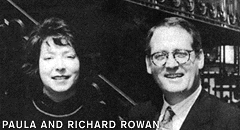THE SCHOOL IN THE SWAMP
Richard and Paula Rowan founded SCAD in 1978. At the time, they were educators in Atlanta. But Savannah's cobblestone streets, stately town houses, and old cemeteries enticed them to move there to pursue a greater calling. The Rowans took out a $200,000 loan, bought an empty armory building in Savannah's historic district, and started an art college.

|
The Rowans also gained from SCAD, even though the school was set up as a nonprofit organization. Last year the couple earned a combined $600,000, making them among the most highly paid educators in the country, despite the school's minuscule endowment and relatively small size. (SCAD's spokesperson, Avis Coleman, says the Rowans didn't get paid during the early years, so, averaged out, they've pulled in around $175,000 a year.) The Rowans own two Rolls-Royces, a Jaguar, and more than twenty racehorses; they live at the Landings, a gated subdivision outside of town. The couple has generously spread their wealth among family members: Paula Rowan's father, mother, sister, and brother-in-law are all on the SCAD payroll.
The couple's ostentation and backwoods flair alienated them from some of the locals-who have deemed the couple the "Jim and Tammy Faye Bakker of education"-but their unpopularity did nothing to hinder SCAD's growth. The Rowans displayed an incredible zeal for business and had a clever strategy for promoting their school. Rather than gear their curriculum toward traditional painting and sculpture classes, they focused on more marketable skills like computer animation and graphic design. This technology-driven curriculum-with its attendant promise of job opportunities-allowed parents to justify spending roughly $17,000 a year. In the late Eighties and early Nineties, the strategy paid off, as SCAD grew to two thousand students and established a reputation as a lavishly equipped institution in a sultry locale. As an observer remarked, "The jalopy had turned into a Cadillac." The Rowans lured prominent backers like novelist Pat Conroy and syndicated columnist Joyce Maynard to SCAD's board. The atmosphere was electric and tinged with optimism. Professors felt they were part of "a new Bauhaus," as one put it.
The Rowans themselves were seen only in glimpses, giving campus tours or scurrying across Savannah's oak-canopied squares to check on building renovations-he in a dark suit, polka-dot tie, and round tortoiseshell glasses, chin in the air; she in a blazer and skirt, dark-haired and slight, a little chubby. There was something mysterious about them, a cloaked, Gatsby-like aura. And like Gatsby's Long Island neighbors, Savannahians concocted elaborate tales to account for the couple's lifestyle and for SCAD's incredible growth. When a red double-decker bus appeared downtown as SCAD's campus shuttle, locals gossiped that the school was financed by the English throne. Savannahians also hypothesized that the Rowans, who do not have artistic backgrounds, were inspired to start SCAD because of financial success at another nonprofit institution: Anneewakee, a Georgia psychiatric treatment center for adolescents founded by Paula's uncle, Louis Poetter. Poetter was later sued for racketeering and charged with sexual misconduct. (In 1988 he pled guilty to nineteen counts of sodomizing young boys entrusted to his care.) The Rowans' fiercest critics said SCAD was, in financial terms, akin to Anneewakee-a nonprofit organization set up for personal gain. When I asked a SCAD spokesperson about the Anneewakee rumors, she said, "I've never heard that one, but I have heard 'the Mafia.'" In Savannah, even the publicists gossip.